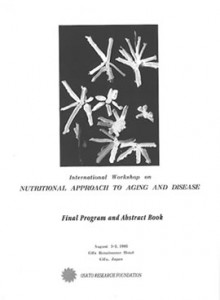| Title | Efficacy of Different Standardized Natural Compounds Against Oxidative Stress |
|---|---|
| Year | 1994 |
| Author | L. Marcocci; N. Haramaki; R. D’Anna; L.J. Yan; H. Kobuchi; L. Packer |
| Publisher | International Workshop on Nutritional Approach to Aging and Disease |
EFFICACY OF DIFFERENT STANDARDIZED NATURAL
COMPOUNDS AGAINST OXIDATIVE STRESS
L. Marcocci, N. Haramaki, D’ Anna R., L-J. Yan, H. Kobuchi and L. Packer.
Department of Molecular and Cell Biology, University of California, Berkeley,
CA 94720-3200
A variety of biological model systems of oxidative stress have been used in our laboratory to test the antioxidant properties of different natural products. Ginkgo biloba leave extract, EGb 761, scavenges nitric oxide, superoxide, hydroxyl and peroxyl radicals in vitro. It also inhibits the activity of xanthine oxidase, and suppresses the expression of nitric oxide synthase mRNA in mice’s macrophages. In in vitro experiments, EGb 761 protected human low density lipoprotein against oxidative modification induced by peroxyl radicals or by copper. Perfusion with EGb 761 of isolated rat hearts in a Langendorff apparatus, improved cardiac mechanical recovery, suppressed the lactate dehydrogenase leakage, and protected against the depletion of ascorbate during reperfusion. Perfusion with TJ-960, an extract of nine different herbs, improved the contractile function of isolated rat hearts, suppressed the lactate dehydrogenase leakage and prevented the formation of tissue protein carbonyl derivatives induced by ischemia-reperfusion treatment. Oral supplementation of rats with Bio-Normalizer, a natural product prepared by yeast fermentation of plants, suppressed the lactate dehydrogenase leakage in isolated rat heart exposed to ischemia-reperfusion in a Langendorff apparatus and protected heart and kidney homogenates’ lipids and proteins against oxidation induced by AMVN-generated peroxyl radicals. However, Bio-Normalizer supplementation did not prevent oxidative damage in the liver or in the brain. In conclusion, compounds with antioxidant properties are available that could be important pharmacological agents for the treatment or for the prevention of oxidative damage-mediated pathogenesis.
– 21 –
